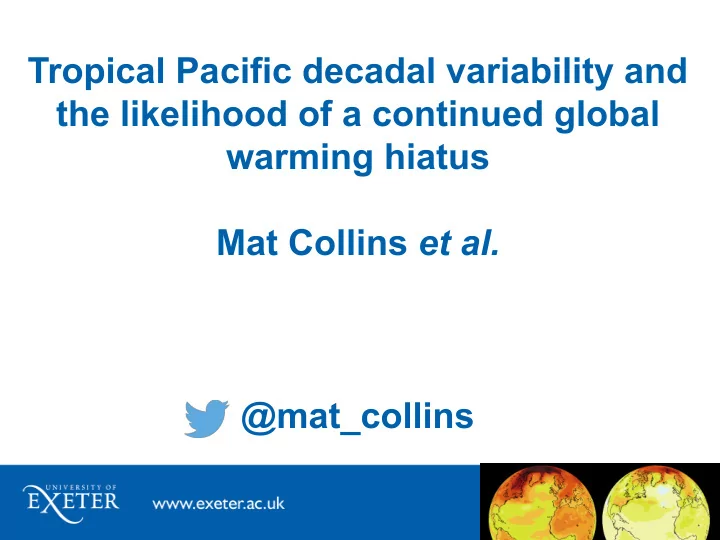

Tropical Pacific decadal variability and the likelihood of a continued global warming hiatus Mat Collins et al. @mat_collins
Roberts et al. 2015 • Estimate forced response by averaging CMIP5 historical simulations (+ test sensitivity to this assumption) • Generate large synthetic ensemble by adding control run variability to the forced response • [Sub-select models based on some metrics of ability to simulate interannual variability – makes little difference] • Estimate probability of occurrence of hiatus events and ‘surge’ or accelerated warming events • Look at TOA and ocean heat budget during events Roberts, Palmer, McNeall, MC 2015
Warming ‘Pause’ or ‘Hiatus’ +0.2°C/decade Roberts, Palmer, McNeall,MC, 2015
Probability of Natural Variability Overcoming a Forced Trend of +0.2°C/decade Roberts, Palmer, McNeall, MC 2015
Roberts et al. 2015
Roberts et al. 2015 Summary Focusing on natural internal variability as the cause and assuming an expected forced response of 0.2°C/decade • The probability of a variability-driven 10-year hiatus is ∼ 10 %, but less than 1 % for a 20-year hiatus • Although the absolute probability of a 20-year hiatus is small, the probability that an existing 15-year hiatus will continue another five years is much higher (up to 25 %) • Therefore we should not be surprised if the current hiatus continues until the end of the decade • An accelerated warming following termination is more likely than not Roberts, Palmer, McNeall, MC 2015
Fyfe et al., unpublished • Forecasts from Canadian seasonal forecasting system
Fyfe et al., unpublished • 150 member ensemble of CanESM2 1961-2020, historical/RCP8.5 forcing • Analogue forecasts based on matching Nino3.4 anomalies over the past 12 months • Global mean temperature remains above 2000-2014 average throughout 2016-17
Met Office Seasonal Forecasts (Nov) Nino3 Nino4
SST Trends 1979-2014 • HadISST trends over the period where satellite data are available show marked east Pacific cooling • Not seen in CMIP5 ensemble mean (historical + RCP4.5)
Null Hypothesis: It’s a Trend In fact, observed trends are outside the range of modelled trends (CMIP5 Historical + RCP4.5)
Pacific Trends 1979-2014 2015
Theories of SST Changes There are opposing theories of greenhouse-gas induced long-term SST trends • Local maximum of equatorial warming across the basin due to weakening trades (Liu et al., 2005; Xie et al. 2010) • Ocean ‘dynamical thermostat’ hypothesis predicting cooling in the east with respect to the west due to the upwelling of cold water from depth (Clement et al. 1996) • Other hypotheses predicting warming in the east relative to the west (Knutson; Manabe 1995) • These are really theories of equatorial SST changes. Observed patterns are meridionally broader
Pacific Multi-Decadal Variability Are these really (i) forced trends in the Pacific, or (ii) just large-amplitude decadal variability? • If (i), then we need to revise our theories of forced Pacific trends • If (ii), then real-world decadal variability is larger than seen in models (Scott’s talk) • Could be fluke large-amplitude natural variability, but this is usually called ‘detection’ in climate science • Are we now entering a positive PDO phase/global warming ‘surge’?
DCV Questions/Issues • Closing the global energy budget has been an important milestone in climate science but it seems that decadal variability involves variations of the order of tenths of Wm -2 per decade – hard to measure • Understanding spatial fingerprints, mechanisms and impacts are obviously key • Excessive focus on oceanic variables? Role of atmospheric dynamical processes? • Spatial responses to forcings not well quantified • Conundrum: Atlantic seems more predictable than the Pacific but the Pacific seems more influential at global scales
Errors/Biases in Mean Climate IPCC Ch9, Fig 9.14 • Equatorial Pacific SSTs generally too cold • Trade winds are too strong • Equatorial dry bias, off Obs equatorial wet bias CMIP3 and ‘double ITZC’ CMIP5 • …
Recommend
More recommend